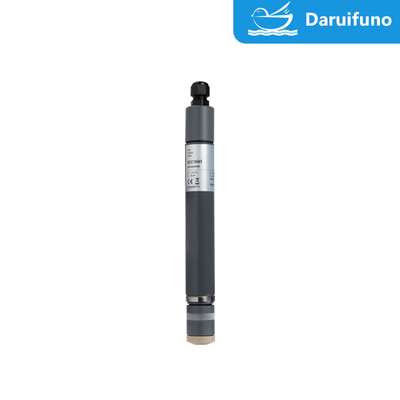4-20MA Or RS485 Residual Chlorine Sensor CC1 With Flow Cell For Swimming Pool
The Modbus film-attached chlorine sensor CC1 has many advantages in automation and remote monitoring applications:
Remote monitoring and control: The Modbus communication protocol allows the residual chlorine sensor to communicate with equipment such as monitoring systems, PLCs (programmable logic controllers) or SCADA (supervisory and data acquisition systems). This means that users can monitor the residual chlorine concentration in real time and control it remotely from a remote location without having to be on site.
Data integration: Using Modbus, the residual chlorine sensor can directly integrate the measurement data into the control system, making data processing easier. This can be integrated with data from other sensors and devices to provide comprehensive monitoring and control.
Real-time data update: Modbus communication allows the chlorine sensor to update data in real-time. This is important for applications that need to quickly understand changes in water quality so that immediate action can be taken to keep the water safe.
Highly configurable: Modbus communication allows users to configure according to their needs, including data transmission rate, communication protocol and other parameters. This means that the sensor can be adapted to different monitoring environments and needs.
Remote Diagnosis and Maintenance: Through Modbus communication, users can remotely diagnose sensor performance, monitor sensor status, detect faults and perform maintenance, thereby reducing downtime and maintenance costs.
Data recording and historical analysis: Using Modbus communication, the residual chlorine sensor can transmit historical data to the monitoring system, allowing users to perform data analysis and trend analysis, so as to better understand water quality changes.
Alarms and notifications: Through Modbus communication, the sensors can send alarms and notifications to the monitoring system, so that timely measures can be taken when problems or abnormal conditions occur.
In conclusion, the combination of Modbus communication protocol and membrane-attached residual chlorine sensor can improve the efficiency and accuracy of water quality monitoring, especially in applications that require remote monitoring, control, and data integration. This integration enables users to better manage water quality, reduce risk, and improve the efficiency of production or treatment processes.
Specifications
| Indicator |
Free chlorine |
| pH Range |
4-12pH |
| Pressure Range |
0~0.5 bar, no pressure surges or fluctuations |
| Temperature Range |
0~45℃ |
| Temp Compensation |
Integrated automatic temperature compensation |
| Response Time |
T90 2mins |
| Flow Rate |
About 30 L/h, low flow-dependence |
| Shaft Length |
Diameter is 25mm standard 175 mm, and up to 220 mm in length (mA-Version) |
| Connection |
2-pole terminal or M12 male |
| Material |
PVC-U, PEEK, stainless steel 1.4571, microporous hydrophilic membrane |
| Scope of Supply |
Sensor, membrane cap, electrolyte |
| Signal Output |
4~20mA/Modbus RTU(Optinal) |
| Application |
Swimming pool, suitable for the determination of free chlorine based on isocyanic acid, and also for the determination of free chlorine in seawater.
|
| Item Number |
Model |
Measuring range
(ppm)
|
Resolution(ppm)
|
Output signal |
Power supply |
| 3426610 |
CC1H-M0c |
0.005-2.000 |
0.001 |
Modbus RTU |
9-30V DC
20-56mA
|
| 3426611 |
CC1N-M0c |
0.05-20.00 |
0.01 |
| 3326094 |
CC1MA2 |
0.01-2.00 |
0.01 |
4-20mA |
12-30V DC
RL:50-900Ω
|
| 3326096 |
CC1MA5 |
0.01-5.00 |
0.01 |
| 3326095 |
CC1MA10 |
0.01-10.00 |
0.01 |
| 3326107 |
CC1MA20 |
0.01-20.00 |
0.01 |
| 3426615 |
CC1MA2-M12 |
0.01-2.00 |
0.01 |
4-20mA |
12-30V DC
RL:50-900Ω
|
| 3426616 |
CC1MA5-M12 |
0.01-5.00 |
0.01 |
| 3426617 |
CC1MA10-M12 |
0.01-10.00 |
0.01 |
| 3426618 |
CC1MA20-M12 |
0.01-20.00 |
0.01 |

Chlorine sensor with membrane-covered, amperometric 3-electrode system. For the measurement of free chlorine on the basis of isocyanuric acid, also in seawater.
Areas of application: Fresh water and seawater; Surfactants are tolerated in part; a special electrolyte is used for seawater.
Scope of supply: CC1: sensor, membrane cap, electrolyte for use in fresh water use
Product description:
1. Measurand(s): NaClO (sodium hypochlorite), Ca(ClO)2 (calcium hypochlorite), Cl2 (chlorine gas), electrolytically generated chlorine, and organic combined chlorine based on iso-cyanuric acid (tested up to an iso-cyanuric acid concentration of 500 mg/l)
2. Calibration: At the controller, via analytical chlorine determination by DPD 1 method. Observe the iso-cyanuric acid concentration when determining the free chlorine
3. Interferences: ClO2 is 100 % detected, O3 is detected
4. pH range: 4~12, greatly reduced pH dependence
5. Pressure range: 0~0.5 bar, no pressure surges and/or fluctuations
6. Temperature range: 0~45 ℃, (no ice crystals in test water allowed)
7. Integrated automatic temperature compensation
8. Response time: T90 about 2 min. 9. Flow rate: about 30 l/h, low flow dependence
10. Shaft length: Standard 175 mm, and up to 220 mm in length (mA-Version)
11.Connection: For mA-version 2-pole terminal, M12 male or Modbus RTU with M12 male
12.Material: PVC-U, PEEK, stainless steel 1.4571, microporous hydrophilic membrane

 Your message must be between 20-3,000 characters!
Your message must be between 20-3,000 characters! Please check your E-mail!
Please check your E-mail!  Your message must be between 20-3,000 characters!
Your message must be between 20-3,000 characters! Please check your E-mail!
Please check your E-mail! 









